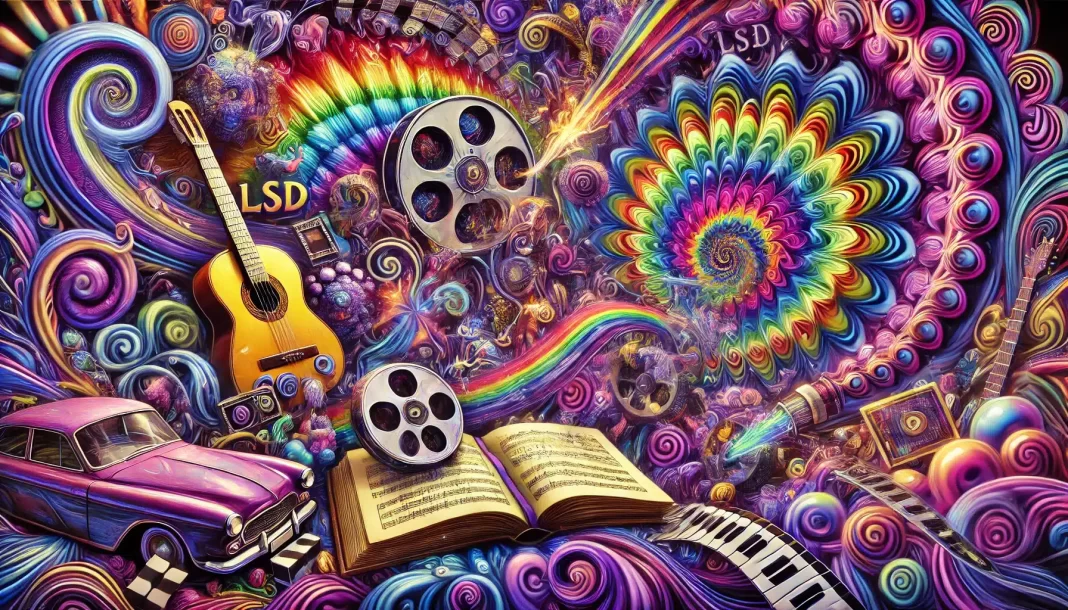Since its emergence in the mid-20th century, LSD (lysergic acid diethylamide) has not only shaped personal and spiritual experiences but also left an indelible mark on popular culture. From music and film to literature, LSD has profoundly influenced how we understand and express human consciousness, creativity, and the boundaries of reality. Through its powerful effects on perception, imagination, and the subconscious mind, LSD has inspired some of the most groundbreaking and influential works in modern art and culture.
This article explores how LSD has influenced popular culture such as music, film, and literature, examining its role in the creative process and how it has reshaped the way artists think about reality, identity, and expression.
The Impact of LSD on Popular Culture: From Psychedelic Rock to Surreal Cinema
LSD and Music: Shaping the Sound of the 1960s and Beyond
LSD’s influence on music is perhaps its most well-known cultural legacy. In the 1960s, the psychedelic movement exploded into the mainstream, with LSD playing a central role in the creation of psychedelic rock and influencing some of the most iconic bands and albums of the era. Artists who took LSD often described it as opening up new ways of thinking about sound, allowing them to break free from traditional structures and experiment with innovative melodies, abstract lyrics, and unconventional recording techniques.
The Beatles: The Beatles’ 1967 album, “Sgt. Pepper’s Lonely Hearts Club Band,” is a landmark in psychedelic music, with its swirling sounds, experimental studio effects, and lyrics that evoke dreamlike states. Songs like “Lucy in the Sky with Diamonds” (often interpreted as a reference to LSD) reflect the band’s experiences with the drug, which they used to explore the boundaries of consciousness and challenge conventional musical norms.
Pink Floyd: Another pioneering psychedelic band, Pink Floyd, created music that mirrored the LSD experience with long, flowing compositions and vivid, otherworldly soundscapes. Their album “The Piper at the Gates of Dawn” (1967) is considered one of the defining works of psychedelic rock, capturing the sense of disorientation, euphoria, and expansiveness that characterize an LSD trip.
The Grateful Dead: Perhaps no band is more closely associated with LSD than The Grateful Dead, whose live performances became central to the countercultural experience of the 1960s. The band was deeply connected to the Acid Tests, a series of LSD-fueled parties hosted by Ken Kesey and the Merry Pranksters, where music, light shows, and communal tripping merged into a single, immersive experience. The Grateful Dead’s improvisational style and the communal ethos of their concerts became synonymous with the psychedelic experience, where the music and the trip were inseparable.
LSD’s impact on music has extended far beyond the 1960s. Its influence can still be heard in modern genres such as electronic music, indie rock, and experimental pop, where artists continue to push the boundaries of sound and explore the connection between altered states of consciousness and musical expression.
LSD and Film: Exploring Reality and Consciousness on Screen
LSD’s influence on film has been equally profound, inspiring filmmakers to explore subjective reality, hallucinations, and altered states of mind. LSD trips, with their kaleidoscopic visuals, time distortions, and ego dissolution, have provided a rich source of material for cinematic experimentation.
2001: A Space Odyssey: Stanley Kubrick’s 1968 science fiction masterpiece “2001: A Space Odyssey” is often cited as one of the most visually stunning films of all time, and its famous “Stargate” sequence is frequently compared to an LSD trip. The film’s exploration of cosmic consciousness, the nature of existence, and humanity’s place in the universe echoes the themes often encountered during psychedelic experiences, where individuals feel connected to something larger than themselves.
Easy Rider: The 1969 film “Easy Rider” is another cultural touchstone, not just for its depiction of the counterculture, but also for its portrayal of drug use and the search for freedom. In one of the film’s most memorable scenes, the protagonists take LSD in a New Orleans cemetery, leading to a fragmented, disorienting sequence that reflects the internal chaos of an intense psychedelic experience.
Fear and Loathing in Las Vegas: Based on Hunter S. Thompson’s semi-autobiographical novel, “Fear and Loathing in Las Vegas” (1998) directed by Terry Gilliam brings to life the chaotic, surreal nature of an LSD trip. The film’s distorted visuals, bizarre characters, and fluid sense of reality mirror the way psychedelics can warp perception, making it one of the most iconic depictions of LSD in modern cinema.
LSD has also influenced filmmakers on a deeper level, prompting them to explore the concept of reality itself. Films like “The Matrix” (1999) and “Inception” (2010), while not directly about LSD, deal with the blurred line between dream and reality, echoing the existential questions that often arise during psychedelic experiences. These films challenge viewers to question their perceptions of the world, much like LSD does for its users.
LSD and Literature: Expanding the Boundaries of Thought and Language
LSD has been a significant influence on some of the most daring and experimental works of literature, particularly in the beat and counterculture movements. Authors who used LSD often described the drug as a tool for expanding their minds, unlocking new ways of thinking about language, consciousness, and the nature of reality.
Aldous Huxley: While Huxley is best known for his novel “Brave New World,” he is also a foundational figure in the modern psychedelic movement. In his essay “The Doors of Perception” (1954), Huxley recounts his experience with mescaline, a psychedelic similar to LSD, and reflects on how psychedelics can reveal the mind’s ability to transcend ordinary reality. His writing became a touchstone for the intellectual and spiritual exploration of psychedelics, influencing figures like Timothy Leary and the broader counterculture movement.
Ken Kesey: As the author of “One Flew Over the Cuckoo’s Nest” (1962) and the leader of the Merry Pranksters, Ken Kesey was instrumental in bringing the psychedelic experience into the cultural mainstream. His novel, which explores themes of control, freedom, and institutional oppression, was influenced by his own experiences with LSD while participating in a government-sponsored research program in the early 1960s. Kesey’s later work, including his participation in the Acid Tests, cemented his role as a literary voice of the psychedelic era.
Hunter S. Thompson: A key figure in the gonzo journalism movement, Hunter S. Thompson famously incorporated his experiences with drugs—including LSD—into his writing. His most famous work, “Fear and Loathing in Las Vegas” (1971), is a wild, hallucinatory journey through a landscape shaped by both American excess and the crumbling ideals of the 1960s counterculture. Thompson’s frenetic, surreal style mirrored the chaos of an acid trip, using hyperbole, vivid imagery, and dark humor to capture the essence of a world teetering on the edge of reality.
LSD’s influence on literature extends to avant-garde and postmodern writers who used the psychedelic experience as a metaphor for the fractured, unstable nature of reality in the modern world. Authors like Thomas Pynchon and William S. Burroughs incorporated elements of the psychedelic experience into their work, using fragmented narratives, nonlinear storytelling, and hallucinatory imagery to challenge traditional literary forms and explore the boundaries of consciousness.
LSD as a Catalyst for Artistic Innovation
LSD’s ability to disrupt normal patterns of thought and perception has made it a powerful tool for artistic innovation across all forms of media. By breaking down the usual boundaries of logic and ego, LSD allows artists to tap into subconscious material, generating ideas, images, and sounds that would otherwise remain inaccessible. This has led to the creation of works that challenge conventional modes of storytelling, music composition, and visual art.
One of the key effects of LSD is its capacity to expand the mind’s ability to see connections between seemingly unrelated concepts or ideas. This “cognitive fluidity” can lead to moments of creative insight, where new possibilities for artistic expression emerge. Whether in music, film, or literature, LSD has inspired countless artists to push the limits of their craft, creating works that defy categorization and open new pathways for understanding the human experience.
The Enduring Legacy of LSD in Popular Culture
While LSD’s popularity peaked during the 1960s and 1970s, its influence on popular culture continues to resonate today. The psychedelic aesthetic, characterized by vibrant colors, surreal imagery, and mind-bending visuals, remains a powerful force in art, fashion, and design. In music, the spirit of experimentation that LSD fostered continues to inspire artists across genres, from psychedelic rock to electronic music and hip-hop.
In the realm of film and literature, the themes of altered reality, self-exploration, and existential questioning that LSD brought to the forefront are still central to some of the most thought-provoking works of the 21st century. As psychedelics experience a resurgence in clinical research and public interest, their influence on culture is likely to continue evolving, shaping the way we think about art, creativity, and the mind.
Conclusion: LSD’s Cultural Impact on Creativity and Consciousness
LSD has had a profound impact on popular media, influencing music, film, and literature in ways that continue to shape contemporary culture. By breaking down barriers of perception and encouraging creative exploration, LSD has inspired some of the most iconic and influential works in modern history. From the psychedelic sounds of the 1960s to the mind-bending films of the present day, LSD has opened doors to new ways of seeing the world and expressing the complexities of human consciousness.
As society continues to grapple with the possibilities and challenges of altered states of mind, LSD’s legacy as a catalyst for artistic innovation and creative insight remains as relevant as ever.





